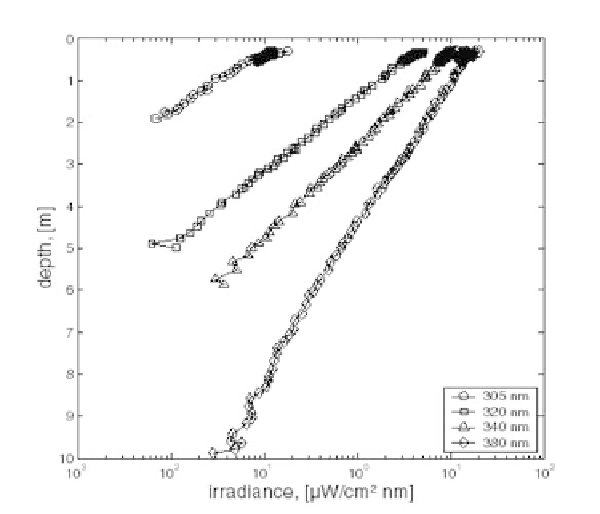Environmental Engineering Reference
In-Depth Information
elevation and other atmospheric conditions. Downward irradiance decreased
exponentially with depth (note the logarithmic irradiance scale).
Figure 2.
Downward irradiance measured simultaneously at 305 nm, 320 nm, 340 nm and 380 nm as
a function of depth. Measured in Trondheim Fjord, Norway (63° 29' N, 10° 18' E)
UV attenuation can be expressed by different quantities. The profiles in Figure 2
show directly how the irradiance decreased with depth for different wavelengths. The
attenuation can be described by the slope of the profiles according to equation
k
d =
-ln(E
d
/E
s
)/z (1)
where k
d
is the diffuse downwelling attenuation coefficient [m
-1
], E
d
is downwelling
irradiance [µW cm
-2
nm
-1
] measured at depth z, E
s
is downwelling irradiance measured
at z = 0, approximately 0.2 m below the surface. K
d
is calculated according to
Equation 1 after a linear regression of the data sampled between two depths, given
relatively to the surface measurements. Presenting the underwater profile measurements
relative to the surface unit will smoothen the profiles obtained during rapidly changing
cloud cover. Diffuse attenuation coefficients can be retrieved from relative profiles with
increased accuracy (Figure 3). In a water column with high stratification k
d
will change
with depth. k
d
for ultraviolet radiation is less dependent on solar elevation than k
d
in the
PAR region, because most of the ultraviolet radiation from the sky is diffuse
2
.
Very often attenuation of radiation in a water column is presented as the depth to
which 10% (Z(10%)) or 1% (Z(1%)) of the surface irradiance is penetrating, rather than

Search WWH ::

Custom Search